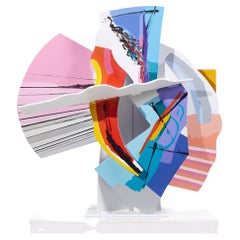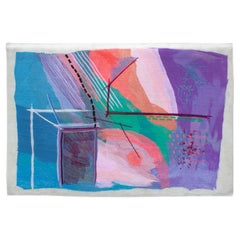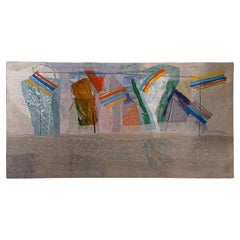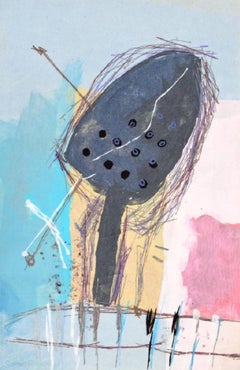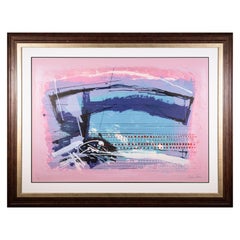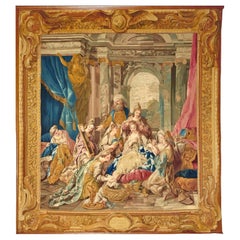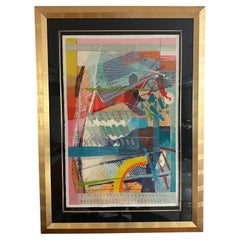Calman Shemi Art
to
1
14
14
14
5
4
1
Shemi Post Modern Abstract Metal Sculpture
By Calman Shemi
Located in Countryside, IL
Shemi Post-Modern Abstract Metal Sculpture
This sculpture measures: 24 wide x 14 deep x 25 high
We take our photos in a controlled lighting studio to show as much detail as possibl...
Category
1990s Argentine Post-Modern Calman Shemi Art
Materials
Metal
Calman Shemi Signed “Escape Through a Side Door #8” Soft Painting Tapestry
By Calman Shemi
Located in Indianapolis, IN
A soft painting tapestry by the Argentinian-Israeli artist Calman Shemi (born 1939). Titled Escape Through a Side Door #8, this work uses felted material in bright colors to create ...
Category
Late 20th Century Israeli Modern Calman Shemi Art
Materials
Fabric
Calman Shemi First Light at Dawn Tapestry, 1990
By Calman Shemi
Located in Chicago, IL
Calman Shemi First Light at Dawn Tapestry, Signed 1990's. There is a slight water mark on upper right side.
Calman Shemi uses a great mix of colors, textures and shapes. He also deve...
Category
1990s Argentine Post-Modern Calman Shemi Art
Materials
Natural Fiber, Paint
Modernist Israeli Soft Tapestry Wall Hanging Rug Calman Shemi
By Calman Shemi
Located in Surfside, FL
this is a bright vibrant abstract wall hanging tapestry by Calman Shemi. I believe the material is wool with a linen backing but i am not positive. it can also be used as a floor rug...
Category
1980s Abstract Expressionist Calman Shemi Art
Materials
Wool, Mixed Media
Calman Shemi Manuscript 1989 Abstract Modern Signed Lithograph 90/300 Framed
By Calman Shemi
Located in Keego Harbor, MI
An expressive and lively lithograph titled "Manuscript" from artist Calman Shemi. Hand signed in pencil on the bottom right with an annotation of 90/300 on the bottom left. This love...
Category
1980s Vintage Calman Shemi Art
Materials
Paper
Calman Shemi Large Format Wall Tapestry, 1978
By Calman Shemi
Located in Miami, FL
Monolithic wool wall tapestry by artist Calman Shemi dated 1978. Can be hung horizontal or vertical.
Calman Shemi
Argentine/ Israeli
1939 -
Tapestry
Signed and dated near lowe...
Category
1970s Argentine Modern Vintage Calman Shemi Art
Materials
Wool
Abstract #5 Large Tapestry
By Calman Shemi
Located in Delray Beach, FL
Abstract #5 acrylic on wool.
Calman Shemi, sculptor and painter, was born in Argentina in 1939. A graduate of the school of Sculpture and Ceramics in Mendoza, Calman Shemi was a stu...
Category
1980s Abstract Calman Shemi Art
Materials
Wool, Acrylic
Stendhal #2 Soft Tapestry wall hanging
By Calman Shemi
Located in Surfside, FL
this is a bright vibrant abstract wall hanging tapestry by Calman Shemi. I believe the material is wool with a linen backing but i am not positive. it can also be used as a floor rug.
Calman Shemi, sculptor and painter, was born in Argentina in 1939. A graduate of the School of Sculpture and Ceramics in Mendoza, he studied under the Italian-Argentinean sculptor Libero Badii whom he credits with putting him on the right path. “He taught me principals, not only related to sculpture, but human and philosophic principals. Shemi also carefully studied the work of such masters as Picasso, Caravaggio, Frank Stella and Matisse. “From each one of these great artists I learned something from observing them,” he says.
In 1961, at the age of 20, Shemi immigrated to Israel and joined Kibbutz Carmia of which he was a member for twenty years. There he worked in agriculture and also as a sculptor working with wood and clay. Several of his large-scale fiberglass and polyester projects are situated in public buildings. He was a student of German-Israeli sculptor Rudi Lehmann, a pioneer of the artistic movement known as “Canaanism.”
Canaanite art was an effort to create a direct relationship with the land, bypassing historic Jewish connotations—hence the land’s primordial name is used. Canaanite works, with an emphasis on the inter-action of simple shapes, bear a deliberate resemblance to the sculpture and ritual art of early civilizations of the Middle East prior to Judaism, always with an eye to the fusion of man and the land itself.
Though sculpture dominated his early years as an artist, in the mid ’70s Shemi developed the idea of the “soft painting” medium. Beginning with a color drawing done to scale, Shemi layers onto the drawing irregularly shaped pieces of variously textured and colored fabrics. Using a threadless 9,000-needle sewing machine, the fabrics are meshed to one another and to the background, resulting in vibrant carpet...
Category
1980s Abstract Expressionist Calman Shemi Art
Materials
Mixed Media
Large Original Abstract Colorful Oil Painting Israeli Kibbutz Landscape Shemi
By Calman Shemi
Located in Surfside, FL
Life in Nature
Canvas measures 31.5 X 39.5
(I believe this is oil it might also be acrylic.)
Hand signed recto and signed and titled verso.
Calman Shemi, sculptor and painter, was born in Argentina in 1939. A graduate of the School of Sculpture and Ceramics in Mendoza, he studied under the Italian-Argentinean sculptor Libero Badii whom he credits with putting him on the right path. “He taught me principals, not only related to sculpture, but human and philosophic principals. Shemi also carefully studied the work of such masters as Picasso, Caravaggio, Frank Stella and Matisse. “From each one of these great artists I learned something from observing them,” he says.
In 1961, at the age of 20, Shemi immigrated to Israel and joined Kibbutz Carmia of which he was a member for twenty years. There he worked in agriculture and also as a sculptor working with wood and clay. Several of his large-scale fiberglass and polyester projects are situated in public buildings. He was a student of German-Israeli sculptor Rudi Lehmann, a pioneer of the artistic movement known as “Canaanism.”
Canaanite art was an effort to create a direct relationship with the land, bypassing historic Jewish connotations—hence the land’s primordial name is used. Canaanite works, with an emphasis on the inter-action of simple shapes, bear a deliberate resemblance to the sculpture and ritual art of early civilizations of the Middle East prior to Judaism, always with an eye to the fusion of man and the land itself.
Though sculpture dominated his early years as an artist, in the mid ’70s Shemi developed the idea of the “soft painting” medium. Beginning with a color drawing done to scale, Shemi layers onto the drawing irregularly shaped pieces of variously textured and colored fabrics. Using a threadless 9,000-needle sewing machine, the fabrics are meshed to one another and to the background, resulting in vibrant carpet tapestry compositions infused with exuberant color and explosive movement. These are neither aubusson nor pile but more of a felt wall hanging...
Category
1980s Abstract Geometric Calman Shemi Art
Materials
Canvas, Oil
Structure 11 Acrylic On Wool
By Calman Shemi
Located in Delray Beach, FL
Structure #11 acrylic on wool.
Hand signed and titled on verso.
Calman Shemi, sculptor and painter, was born in Argentina in 1939. A graduate of the school of Sculpture and Cerami...
Category
1990s Abstract Calman Shemi Art
Materials
Wool, Acrylic
Large Israeli Colorful Metal Wall Sculpture Painting Circus Scene Calman Shemi
By Calman Shemi
Located in Surfside, FL
Calman Shemi (1939-)
Laser cut metal wall sculpture 3D
Titled "Circus"
Signed on the front lower left edge, and signed, numbered, and titled verso.
Marked, Jerusalem
Limited edition, 2/99 (I don't know how many were actually made)
Approx. 34.5" x 35.5"
Depicts weightlifter, acrobats, figure on unicycle, clown with umbrella, and acrobat under the circus big top...
Category
1990s Contemporary Calman Shemi Art
Materials
Metal
Colorful Abstract Lithograph by Calman Shemi
By Calman Shemi
Located in Long Island City, NY
Artist: Calman Shemi, Argentine (1939 - )
Title: Untitled I
Medium: Lithograph, signed and numbered in pencil
Edition: HC 60/450
Size: 34.5 in. x 26 in. (87.63 cm x 66.04 cm)
Category
Late 20th Century Abstract Calman Shemi Art
Materials
Lithograph
Between Fog & Clarity, Colorful Abstract Lithograph by Calman Shemi
By Calman Shemi
Located in Long Island City, NY
Artist: Calman Shemi, Argentine (1939 - )
Title: Between Fog & Clarity
Medium: Lithograph, signed in pencil
Edition: 300, Dedicated to Michel
Size: 25 in. x 35.5 in. (63.5 cm x 90.17...
Category
Late 20th Century Abstract Calman Shemi Art
Materials
Lithograph
Manuscript, Colorful Abstract Lithograph by Calman Shemi
By Calman Shemi
Located in Long Island City, NY
Artist: Calman Shemi, Argentine (1939 - )
Title: Manuscript
Medium: Lithograph, signed in pencil
Edition: 300, Dedicated to Michel
Size: 25 in. x 35.5 in. (63.5 cm x 90.17 cm)
Category
Late 20th Century Abstract Calman Shemi Art
Materials
Lithograph
Related Items
Tapestry Royal Manufacture of Aubusson, Louis XVI period 1738 at the Gobelins
By Aubusson Manufacture
Located in Madrid, ES
Tapestry from the Royal Manufacture of Aubusson, Louis XVI period , made in 1738 at the Gobelins
One panel from a series of Gobelins tapestries depicting the History of Esther, illustrating Esther seated and attended by handmaidens, one washing her feet in golden basin, another fastening a bracelet, another offering a mirror, all observed by Mordecai, woven in the workshop of Michele Audran after a design by J. F. de Troy.
The Toilet of Esther c.1778-85.Royal Collection Trust-Queens Audience Chamber
Windsor Castle
The Sketches for the Esther Cycle by Jean-François de Troy (1736)
“and the maid was fair and beautiful; whom Mor’decai, ..., took for his own daughter.” (Est. 2:7)
A supple and undulating genius, both a flattering portraitist and a prolix history painter, as well as a brilliant genre painter, in a gallant or worldly vein, Jean-François de Troy (Paris, 1679 – Rome, 1752), solicited, although he had passed the threshold of old age, a new royal commission up to his ambitions. To obtain it, he submitted – successfully - for the approval of the Bâtiments du roi (administration), seven modelli painted in 1736 with his usual alacrity.
Inspired by one of the most novelistic texts of the Old Testament, the Book of Esther, these sketches in a rapid and virtuoso manner were transformed by the artist, between 1737 and 1740 into large cartoons intended to serve as models for the weavers of the Gobelins factory. Showing undeniable ease and skill in the composition in perfect harmony with the sensitivities of the times, the tapestry set met with great success.
The Story of Esther perfectly corresponded to the plan of the Bâtiments du roi to renew the repertoire of tapestry models used for the weavers of the royal factories while it also conformed to the tastes of Louis XV’s subjects for a fantastical Orient, the set for a dramatic tale in which splendour, love and death were combined. Indeed, no tapestry set was woven in France during the 18th century as often as that of Esther.
The series of modelli painted by de Troy during the year 1736 looks to the history of French painting and decoration under Louis XV as much as it does the history of the Gobelins. It probably counts among the most important rococo pictorial groups to have remained in private hands. First the Biblical source illustrated by De Troy which constitutes the base of one of the richest iconographical traditions of Western art will be considered. Then the circumstances and specific character of French civilisation during the reigns of Louis XIV and Louis XV which contributed to making the theme of Esther a relevant subject, both attractive to contemporaries and remarkably in line with the sensitivities of the time will be elucidated.
An examination of the exceptional series of sketches united here, the cartoons and the tapestries that they anticipate as well as a study of their reception will close this essay. The Book of Esther: A scriptural source at the source of rich iconography.
The origin of the Esther tapestry set by Jean-François de Troy – origin and creation of a masterpiece
According to the evidence of one of the artist’s early biographers, the chevalier de Valory, author of a posthumous elegy of the master, read at the Académie royale de peinture et de sculpture on 6 February 1762, it was apparently due to early16 rivalry with François Lemoyne (1688-1737), his younger colleague who had precisely just been appointed First Painter to the King in 1736, that had encouraged François de Troy to seek a commission allowing him to show off his ease and his promptitude at the expense of a rival who was notoriously laborious: “M. De Troy, retaining some resentment of the kind of disadvantage which he believed to have suffered compared with his emulator looked to regain some territory by making use of the facility his rival did not possess.
Lemoyne was excessively long in the creation of his works,and M. De Troy of a rare celerity: consequently, with this particular talent, the latter offered to the court to make paintings appropriate to be executed at the Gobelins Factory; and it is to this circumstance that we owe the beautiful series of the Story of Esther, which would be sufficient alone to give him a great reputation.”17 Beyond the suspicion inspired by the topos, which still constitutes, more or less, a tale of rivalries between artists in ancient literature, there is probably some truth in what Valory reports although A.-J. Dezalier d’Argenville (who indicates rather spitefully that de Troy did not hesitate to “cut prices” to impose himself, benefitting from the productivity assured by the unlikely rapidity of his brush)18 proves to be more evasive: “As he looked to busy himself, he had offered to make the paintings that serve as models for the King’s tapestries cheaply: which did not please his colleagues.
He was given a choice of two tapestry series to be made and he took the Story of Esther and that of Jason”.19 Whether or not the choice was actually left to de Troy (which would appear rather casual on the royal administration’s part all the same), it seems likely that the artist, whose contemporaries extol his “fire”, as the faculty of invention was then called, must have ardently aspired to the possibility of using on a very large scale the “creative genius” with which Dezallier d’Argenville credits him. The decoration of the private apartments, the fashion for which Louis XV had promoted at Versailles and Fontainebleau, offered little opportunity to excel in this area. Other than painting for altarpieces, only tapestries could allow comparison with Lemoyne who had been granted – unfortunately for him – a major decoration: the enormous ceiling of the Hercules Room at Versailles. Favoured by the recent improvement in France’s financial situation, the revival of patronage offered de Troy a commission fitting for him, in a field in which, however, he had hardly any experience.
Anxious to renew the repertoire of models available to the Gobelins factory, the Duc d’Antin, surintendant des Bâtiments du roi from 1708 to 1736 followed by his successor, Philibert Orry comte de Vignory, gave him the task of producing seven large cartoons inspired by the Book of Esther corresponding to the brilliant sketches or modelli which de Troy had produced in one go, or almost (very few preparatory drawings can in fact be linked to the Esther cycle and all seem to be at the execution stage of the cartoons).20 Subjected to the approval of the Administration des Bâtiments according to the procedure in use for projects being planned for the Gobelins, sketches made rapidly during 1736 were approved and the project launched immediately. Thereupon came the news of François Lemoyne’s death, who, ground down by work and a victim of his private torment, committed suicide on 4 June 1737.
Against all expectations, de Troy did not replace his rival in the position of First Painter (which remained vacant until the appointment of Charles Coypel in January 1747), which would perhaps have made him too obviously the beneficiary of the drama. The awarding of the position of Director of the French Academy in Rome came to console him while he had already produced (or he was in the process of finishing), in Paris, three of the seven cartoons of the cycle (The Fainting of Esther finished in 1737 and the Toilet and Coronation of Esther, both finished in 1738).
De Troy, we can see, did not follow the order of the narrative but began with the subjects which apparently offered the least difficulty because he had already depicted them, or because they fall into a strong pictorial tradition (such is the case especially for the Fainting of Esther). He had hardly settled at the Palazzo Mancini in August 1738, when his first task which awaited the new director of the French Academy naturally consisted of honouring the royal commission and finishing without delay the final cartoons of the Story of Esther after the sketches he must have taken with him. As prompt as ever, de Troy discharged himself of the execution of the four remaining cartoons in only two years, by beginning with the largest format which allowed him to strike the imagination and to impose himself as soon as he arrived on the Roman stage: the Triumph of Mor’decai which was finished in 1739 (like Esther’s Banquet).
The following year, the Mor’decai's Disdain and The Sentencing of Haman were brought to an end in the same Neo-Venetian style, obviously tributary to Veronese with its choice of “open” monumental architecture which is characteristic of the entire cycle.21 The series, it should be noted, was almost augmented with some additional scenes in the mid 1740s. Indeed, the first tapestry set finished at the Gobelins in 1744 proved to be unsuitable for the arrangement of the Dauphine’s apartments at Versailles for which it had been intended to decorate the walls the following year (cf infra). Informed of this, de Troy, considering that the story of Esther offered “several good subjects,” immediately offered to illustrate one or new subject among those “which could appear to be the most interesting”.
The directeur des Bâtiments Orry, who managed the State’s accounts, obviously judged it less costly to have one of the tapestries widened to fill in the end of the Dauphine’s bedroom,22 which has probably deprived us of very original compositions, because de Troy had already illustrated the most famous themes, those that benefitted from a strongly established iconographical tradition and from which it was not easy to deviate
The Tapestry Set of the Story of Esther
Placed on the tapestry looms of the Gobelins at the end of the 1730s in Michel Audran’s workshop, the cycle created by de Troy aroused true infatuation. The few hundred tapestries made between 1738 and 1797 – all in high-warp tapestry and woven in wool and silk except for four in low-warp made in Neilson’s workshop – show the impressive success of a tapestry set that was without any doubt the most frequently woven of the 18th century in France.
29 Only three cartoons had been delivered by de Troy in 1738 when the first tapestry set was begun by Audran under the expert eye of Jean-Baptiste Oudry to whom the Directeur général des bâtiments, Philibert Orry had assigned the (weekly) supervision of the weaving. During the summer of 1738, the piece of the Fainting of Esther, which Oudry judged to be admirable, was finished.
During the winter of 1742, Oudry informed Orry that about two ells of the Triumph of Mor’decai had been made “with no faults”,that the Coronation of Esther was finished and that the Esther at her Toilet “a very gracious tapestry” was “a little over half” finished. Exhibited at Versailles in 1743, these two last pieces were admired by Louis XV and the Court.
On 3 December 1744, the set of seven tapestries was finally delivered to the Garde Meuble. It was intended, the honour was not slight, to decorate the apartments of the Infanta Maria Teresa Rafaela of Spain whose marriage to the young Dauphin Louis-Ferdinand had been fixed for the following year (it took place on 23 February 1745). Apparently it was thought that the theme of Esther the biblical heroine and wife of a foreign sovereign was appropriate for the apartments of the Spanish Dauphine.
As early as the month of March, the architect Ange-Jacques Gabriel informed de Troy that her grand cabinet was decorated with the “Esther tapestry set” specifying however that “for lack of two small or one large piece, we have not been able to decorate the end of the room”. This difficulty led immediately to the Banquet episode being woven a second time in two parts (they were delivered to the Garde-Meuble on 30 December 1746) to garnish the panels on each side of the bed of the Dauphine who would hardly enjoy them (she died on 22 July 1746 and the decoration was installed for the new Dauphine Maria Josepha of Saxony).
The appearance of the set’s remarkable border, which imitated a richly sculpted wooden frame, should be mentioned. Conceived in 1738 by the ornamentalist Pierre Josse-Perrot and used in the later weavings until 1768, it tended to reinforce the resolutely painterly appearance of the tapestry set which, in this regard, pushed the art of tapestry as far as its ultimate mimetic possibilities. With the exception of Mor’decai's Disdain which had been removed earlier, the “editio princeps” of the story of Esther (from then on in nine pieces) remained at Versailles until the Revolution. Of the eight surviving tapestries, four are at the chateau of Compiègne and four belong today to the Mobilier National. No less than seven tapestry sets reputed to be complete (one of them in fact only had six tapestries) would be produced officially at the Gobelins up to 1772.
Literature:
1- The Œuvres mêlées of an emulator of Racine, the Abbé Augustin NADAL thus include an Esther. Divertissement spiritual which is exactly contemporary with Jean François de Troy’s cycle since it was performed in 1735 and published in Paris three years later.
2-Le Siècle de Louis XIV, 1751, 1785 ed., p. 96-97 for French ed.
3- Lemoyne and de Troy had been obliged to share the First Prize in the competition organised in 1727 between the most prominent history painters of the Académie Royale.
4- Mémoires…, pub. L. DUSSIEUX et al., 1854, II, p.265.
5-The fact that de Troy, at the risk of falling out with his colleagues, did not hesitate to make use of prices in order to convince the new directeur des Bâtiments Philibert Orry, is confirmed by Mariette who adds tersely “it caused much shouting” (pub. 1851-1860, II, p. 103).
6- Abrégé de la vie des plus fameux peintres…, ed. 1762, IV, p. 368-369 20 Early comments on the painter are inclined to present him as a kind of “pure painter”, doing without the medium of drawing, a few intermediary studies between the Esther sketches and the large cartoons at the Louvre nevertheless show that de Troy used red chalk (see in the catalogue, the notice for the Meal of Esther and Ahasuerus under the entry drawing) to change one or other figure.
7-C. GASTINEL-COURAL (cat. exp. PARIS, 1985, p. 9-13) as well as the article by J. VITTET, exh. cat. LA ROCHE-GUYON, 2001, p. 51-55.
8-The Hermitage in St. Petersburg conserves five tapestries of these two royal gifts whose provenance still awaits elucidation (as far as we are aware). In 1766, the Grand Marshal of Russia, Count Razumovski (or Razamowski), acquired the Fainting and the Banquet extracted from the sixth weaving (J. VITTET, 2001, p. 53).
9- Lettres écrites de Suisse, d’Italie…,quoted by J. VITTET, op. cit., p. 54.
10-The tapestry set remained in the hands of a branch of the Hapsburg-Lorraine family until 1933 (ibid. P. 54).
11-Quoted by Chr. LERIBAULT, 2002, p. 97, note 269.
12-Y. CANTAREL-BESSON, 1992, p. 241.
Catalogue
The Esther at her Toilet
Oil on canvas, 57 x 51 cm Provenance: Painted in 1736 at the same time as the six other modelli of the Story of Esther intended to be presented, for approval, to the direction des Bâtiments du Roi; perhaps identifiable among a lot of sketches by Jean-François de Troy in the post mortem inventory of the amateur, historian and critic Claude-Henri Watelet (1718-1786) drawn up on 13 January 1786 and following days (A.N. T 978, n° 30) then in the sale of the property of the deceased, Paris, 12 June 1786, n° 33; Paris, François Marcille Collection (who owned a series of six sketches from which the Triumph of Mor’decai was missing, see infra); Paris, Marcille Sale, Hôtel Drouot, 12-13 January 1857, n° 36; Asnières, Mme de Chavanne de Palmassy ( ?) collection; Paris, Galerie Cailleux; Paris, Humbert de Wendel collection (acquired from the Galerie Cailleux in 1928); by inheritance in the same family; Paris, Sotheby’s, 23 June 2011, n° 61. In order not to add unnecessarily to the technical commentary on each work, the catalogue raisonné by Chr. Leribault which contains a substantial bibliography on the series should be referred to. The other bibliographical references only concern the publications and exhibitions to have appeared and been presented more recently. Bibliography and Exhibitions: Chr. LERIBAULT, 2002, n° P. 247 (repr.); E. LIMARDO DATURI, 2004, p. 28; Exh. cat. NANTES, 2011, p. 138, n° 34, referred to in note 1; Sotheby’s catalogue, Tableaux anciens et du XIXe siècle, 23 June 2011, n° 61 (repr.).
Related Works:
Tapestry cartoon: The cartoon (oil on canvas, 329 x 320 cm), the third made by the artist in Paris after the sketches had been approved by the direction des Bâtiments, is in the Louvre (Inv. 8315). It previously bore the painter’s signature and the date 1738 (inscriptions which are found on the tapestries). The royal administration paid 1600 livres for it on 21 June 1738 and it was exhibited at the Salon in the year of its creation.
Summary Biography
1679 (27 January): Baptism in Paris (Parish of St. Nicolas du Chardonnet) of Jean-François de Troy, son of the painter François de Troy and Jeanne Cotelle, sister of the painter Jean II Cotelle.
1696-1698: Studies (apparently rather turbulent) at the Académie royale de peinture et de sculpture.
1698-1708: First trip to Italy. Is obliged to leave Rome in January 1711 after a tempestuous affair (a duel?), de Troy extends the traditional Roman experience as a pensionnaire at the Académie de France by also visiting Tuscany where he stays for a long time, Venice (his art in face has a strongly Venetian character) and Genoa.
1708: De Troy (whose father had been elected Director of the Académie royale de peinture et de sculpture on 7 July) is agréé and immediately received at the Académie with Apollo and Diana Piercing with their Arrows the Children of Niobe (Montpellier, Musée Fabre) on 28 July.
1710: First royal commission, paid for on 10 May (a sketch representing “the Promotion of the Order of the Holy Spirit” for the tapestry series of the History of the King).
1716: Jean-François de Troy is elected Assistant Professor at the Academy.
1720: He is appointed Professor.
1723: The artist creates the double portrait of Louis XV...
Category
Early 18th Century French Baroque Antique Calman Shemi Art
Materials
Silk, Wool
W 80.71 in L 124.02 in
"Conversations with Rauschenberg" Mixed Media Abstract Expressionist
Located in Carmel, CA
"Conversations with Rauschenberg" is a 48" x 36" tribute to dialogue and interplay within the abstract expressionist realm, skillfully executed by Lorraine Lawson...
Category
21st Century and Contemporary Abstract Expressionist Calman Shemi Art
Materials
Canvas, Mixed Media, Oil, Acrylic
H 48 in W 36 in D 1.5 in
Amazing Raoul Dufy Aubusson Tapestry- Signed
By Raoul Dufy
Located in Brooklyn, NY
Beautiful, surrealistic design from important early 20th century French modernist painter Raoul Dufy. Titled "La Chevauchee" Signed on the front and cloth label on back. Silkscreen p...
Category
1940s French Vintage Calman Shemi Art
Materials
Linen
Sanchez MOLINA Wall Tapestry
By L. A. Molina
Located in L’ISLE-SUR-LA-SORGUE, FR
Rare macramé tapestry by the artist Sanchez Molina.
Unique piece, signed
Spain, ca.1960
Category
1960s Spanish Mid-Century Modern Vintage Calman Shemi Art
Materials
Textile
Japanese Signed Limited Edition Modern Abstract Framed Print
Located in Studio City, CA
A wonderful abstract Japanese print. Intense composition and colors.
Signed, dated (December 1990), numbered (8/30) and titled in Japanese by the artist.
Appears to be printed ...
Category
1990s Japanese Modern Calman Shemi Art
Materials
Paper
Antique Tapestry Verdure Tapestry Large Handmade French Tapestry 5X7, 1900
Located in New York, NY
Antique Verdure Tapestry French Tapestry Handmade Antique Large Tapestry 1900
Measures: 5.4" x 7.4".
"A magnificent antique French tapestry depicting magnificent verdure and greenery. This piece includes rare black colors. Beautiful colorway, and an easy, chic addition to any space."-Antique Rug Collection
Size
5'4" x 7'3" 163cm x 221cm
Serial ID #
10095k
Design
Verdure
Origin
France
Age
circa 1900
Category
Antique
Pattern
Verdure/Floral/Human Figures
Material
100% Hand Woven Wool
Foundation Material
Cotton
Color
Beige, Green, Black, Brown, Pink, Ivory
Quality
Great
Condition
Great condition, minute low area
About Us~
Welcome to Antique Rug Collection. Your #1 Source for handmade Antique Rugs & Tapestries at great prices, curated by leading industry expert.
We are a 6th Generation antique rug shop with 48+ years of experience working with designers, private clients, dealers, and really anyone looking for a unique antique rug at a great price.
We've made an imprint selling rugs...
Category
Early 1900s French Baroque Antique Calman Shemi Art
Materials
Wool
H 64.18 in W 87.01 in D 0.3 in
Large French Aubusson Pastoral Verdure Tapestry or Wall Hanging
By Aubusson Manufacture
Located in Miami, FL
A vibrant and playful Aubusson tapestry depicting the typical French scenery of castle surrounded by a forest with birds and river in the foreground.
...
Category
Early 20th Century French Aubusson Calman Shemi Art
Materials
Wool
Modern Contemporary Art Signed Limited Edition Abstract Torso Lithograph Print
Located in Studio City, CA
An engaging modern abstract lithographic print that appears to be featuring a human torso/ body - somewhat reminiscent of the abstract works of Henry Moor...
Category
1980s American Modern Vintage Calman Shemi Art
Materials
Wood, Paper
H 27.5 in W 31.5 in D 2 in
Antique French Tapestry Antique Tapestry Handmade Tapestry Verdure Tapestry
Located in New York, NY
Rare Antique French Tapestry handmade Verdure Tapestry
4' x 5'
122cm x 153cm
Circa 1920
A magnificent antique French tapestry depicting a hunting scene amongst a verdure s...
Category
1920s French Vintage Calman Shemi Art
Materials
Wool
H 60.24 in W 48.04 in D 0.48 in
“Aube” Tapestry Signed M.Ray
By Michele Ray
Located in Beirut, LB
Decorative vintage tapestry signed M.Ray.
Entitled ‘Aube’. Woven wool signed by the artist in the lower right corner.
Depicting a nature scene, using earthly colors, of trees with...
Category
Mid-20th Century French Calman Shemi Art
Materials
Wool
"Pure Joy!" Green Mixed Media Collage Contemporary Abstract Expressionist
Located in Carmel, CA
"Pure Joy!" is a 36" x 36" mixed media masterpiece by Lorraine Lawson, celebrated for her abstract expressionist vigor. This piece is a harmonious conf...
Category
21st Century and Contemporary Abstract Expressionist Calman Shemi Art
Materials
Canvas, Mixed Media, Oil, Acrylic
H 36 in W 36 in D 1.5 in
“Allégorie en Musique” Figurative Tapestry Signed “René Fumeron”
By Rene Fumeron
Located in Beirut, LB
Beautiful decorative vintage tapestry signed by René Fumeron.
Entitled “Allégorie en musique”. The tapestry exhibits subtle imperfections in certain areas...
Category
Mid-20th Century French Art Deco Calman Shemi Art
Materials
Canvas
Previously Available Items
Calman Shemi - Boogie Woogie Screenprint in Colors - Signed and Numbered
By Calman Shemi
Located in Alpha, NJ
This is a beautiful screenprint in colors by Calman Shemi. This work is in very good overall condition with vibrant colors. This is a limited edition and is signed and numbered along...
Category
21st Century and Contemporary Argentine Calman Shemi Art
Materials
Paper
Calman Shemi Abstract Expressionist Tapestry, "Lagoon" #6
By Calman Shemi
Located in Skokie, IL
Calman Shemi Tapestry " Lagoon " #6
A beautiful "soft-painted textile" by Argentinian-Israeli sculptor and painter Calman Shemi (b. 1939). This...
Category
1980s Israeli Expressionist Vintage Calman Shemi Art
Materials
Wool, Linen
Contemporary Modern Calman Shemi Still Life Tapestry, circa 1990s
By Calman Shemi
Located in Keego Harbor, MI
A Calman Shemi still life tapestry, circa 1990s. A lovely expressive piece from Argentinian artist Calman Shemi. Shemi is a life long artist who ha...
Category
1990s Calman Shemi Art
Materials
Tapestry
"Head of a Woman" Pastel Colored Abstract Contemporary Metal Sculpture
By Calman Shemi
Located in Houston, TX
Colorful pastel abstract contemporary metal sculpture by Argentinian artist, Calman Shemi. This piece titled "Head of a Woman," resembles a form of a bust, a face silhouette in side view, and a headpiece. The piece features several fun patterns, lines, and shapes that complement the pastel colors around the sculpture. Signed by the artist on the base of the sculpture.
Artist Biography: Calman Shemi, sculptor and painter, was born in Argentina in 1939. A graduate of the School of Sculpture and Ceramics in Mendoza, he studied with the Italian-Argentine sculptor Libero Badii and the German-Israeli sculptor Rudi Lehman.
In 1961, he settled in Israel and joined Kibbutz Carmia where he was a member for twenty years. There he worked in agriculture and also as a sculptor, working in wood and clay.
Shemi has acknowledged many influences in his art and his life; the dramatic colors of his childhood in Argentina, the sun-baked landscape of his home in Israel, the sensuous colorism of Matisse, the philosophies of his art teachers, and even the ritualistic symbols of the ancient past. His working method, which relies on the assistance of skilled artisans to execute much of the technical part of producing his works, affirms Shemi's strong commitment to the communal ethic rooted in his experience on the Kibbutz.
In 1977, Shemi's work became an international symbol of peace when Israel's President Katzir presented a Shemi painting to the late President Anwar Sadat of Egypt.
Sculpture dominated his early years as an artist. In 1977, while living in the Kibbutz he developed the idea of the "soft painting" medium. In his "soft paintings", he begins with a color drawing done to scale. He then layers irregularly shaped pieces of variously textured and colored fabrics resulting in vibrant compositions infused with exuberant color and explosive movement.
In recent years, Shemi has worked intensively with wall sculptures made of painted laser-cut steel, his new field of expression.
Over the last fifteen years, he has held more than seventy one-man-shows in the USA, Japan, Germany, Spain, Belgium and Israel including an exhibition at Saper Galleries in 1991. Several of Shemi's large-scale fiberglass and polyester projects are situated in various public buildings throughout the world.
Calman Shemi also created 1,200 prints for cabins of the "Sensation", a Carnival Cruises oceanliner, large-scale paintings for the liner's suites and the public places. Shemi has also created paintings and sculptures for two other Carnival Cruise Lines: the "Elevation" and the "Paradise".
Permanent collections
- The Spertus Museum of Judaica
- The Chicago Fashion Institute
- King David Hotel...
Category
Late 20th Century Contemporary Calman Shemi Art
Materials
Metal
H 30 in W 15.38 in D 20 in
Calman Shemi Signed Limited Edition "Good Life" Metal Wall Sculpture
By Calman Shemi
Located in Indianapolis, IN
A limited edition metal wall sculpture by Argentinian-Israeli artist Calman Shemi (born 1939). Titled, "Good Life," the colorful sculpture of a still life artistically resembles a tr...
Category
Late 20th Century Israeli Modern Calman Shemi Art
Materials
Metal
Limited Edition 20th Century Calman Shemi "Abstract" Tapestry Rug
By Calman Shemi
Located in San Francisco, CA
Limited Edition 20th Century Calman Shemi "Abstract" Tapestry Rug
Bright, bold and colorful limited edition tapestry by listed artist Calman Shemi
This is number 2 out of 9
...
Category
Late 20th Century American Modern Calman Shemi Art
Materials
Textile
Calman Shemi, "Where the Childrens Meet #18" Tapestry Soft Painting
By Calman Shemi
Located in Norwalk, CT
Calman Shemi, Argentinian (b. 1939).
"Where the Childrens Meet" #18. Branded signature lower left-hand corner; hand-signed, titled, and editioned on verso.
This monumental wall tapestry is an expressive example of Calman Shemi's original "Soft Painting...
Category
Late 20th Century Israeli Calman Shemi Art
Materials
Fabric, Textile
Contemporary Signed Calman Shemi Soft Sculpture Hanging Wall Tapestry, 1980s
By Calman Shemi
Located in Keego Harbor, MI
For your consideration is a breathtaking, abstract tapestry wall art, made of wool, titled "Flash Fire #5," signed by Calman Shemi, circa 1980s. In excellent condition. The dimension...
Category
1980s Vintage Calman Shemi Art
Materials
Wool
H 70 in W 49 in D 0.5 in
Large Original Abstract Colorful Painting Israeli Kibbutz Landscape
By Calman Shemi
Located in Surfside, FL
Calman Shemi, sculptor and painter, was born in Argentina in 1939. A graduate of the School of Sculpture and Ceramics in Mendoza, he studied under the Italian-Argentinean sculptor Li...
Category
1980s Abstract Geometric Calman Shemi Art
Materials
Paint, Archival Paper
Framed Original Abstract Lithograph by Calman Shami Title Spanish Fan
By Calman Shemi
Located in San Diego, CA
A colorful abstract litho by listed artist Calman Shami, circa 1980s framed in white frame unopened nice condition. Edition 290/300; Measures: 35" X 25" without the frame.
Category
Late 20th Century Israeli Post-Modern Calman Shemi Art
Materials
Paper
Modernist Israeli Soft Tapestry Wall Hanging Rug Calman Shemi
By Calman Shemi
Located in Surfside, FL
this is a bright vibrant abstract wall hanging tapestry by Calman Shemi. I believe the material is wool with a linen backing but i am not positive. it can also be used as a floor rug. "Garden Insect #7"
Calman Shemi, sculptor and painter, was born in Argentina in 1939. A graduate of the School of Sculpture and Ceramics in Mendoza, he studied under the Italian-Argentinean sculptor Libero Badii whom he credits with putting him on the right path. “He taught me principals, not only related to sculpture, but human and philosophic principals. Shemi also carefully studied the work of such masters as Picasso, Caravaggio, Frank Stella and Matisse. “From each one of these great artists I learned something from observing them,” he says.
In 1961, at the age of 20, Shemi immigrated to Israel and joined Kibbutz Carmia of which he was a member for twenty years. There he worked in agriculture and also as a sculptor working with wood and clay. Several of his large-scale fiberglass and polyester projects are situated in public buildings. He was a student of German-Israeli sculptor Rudi Lehmann, a pioneer of the artistic movement known as “Canaanism.”
Canaanite art was an effort to create a direct relationship with the land, bypassing historic Jewish connotations—hence the land’s primordial name is used. Canaanite works, with an emphasis on the inter-action of simple shapes, bear a deliberate resemblance to the sculpture and ritual art of early civilizations of the Middle East prior to Judaism, always with an eye to the fusion of man and the land itself.
Though sculpture dominated his early years as an artist, in the mid ’70s Shemi developed the idea of the “soft painting” medium. Beginning with a color drawing done to scale, Shemi layers onto the drawing irregularly shaped pieces of variously textured and colored fabrics. Using a threadless 9,000-needle sewing machine, the fabrics are meshed to one another and to the background, resulting in vibrant carpet...
Category
1980s Abstract Expressionist Calman Shemi Art
Materials
Wool, Mixed Media
Israeli Circa 1980s Painted Aluminum Abstract Sculpture
By Calman Shemi
Located in Surfside, FL
Calman Shemi, sculptor and painter, was born in Argentina in 1939. A graduate of the School of Sculpture and Ceramics in Mendoza, he studied under the Italian-Argentinean sculptor Li...
Category
1980s Abstract Geometric Calman Shemi Art
Materials
Metal
Calman Shemi art for sale on 1stDibs.
Find a wide variety of authentic Calman Shemi art available for sale on 1stDibs. If you’re browsing the collection of art to introduce a pop of color in a neutral corner of your living room or bedroom, you can find work that includes elements of blue, orange and other colors. You can also browse by medium to find art by Calman Shemi in fabric, lithograph, paint and more. Much of the original work by this artist or collective was created during the 20th century and is mostly associated with the abstract style. Not every interior allows for large Calman Shemi art, so small editions measuring 26 inches across are available. Customers who are interested in this artist might also find the work of Alejandro Thornton, Lynda Benglis, and Anne Youkeles. Calman Shemi art prices can differ depending upon medium, time period and other attributes. On 1stDibs, the price for these items starts at $750 and tops out at $5,000, while the average work can sell for $2,500.
